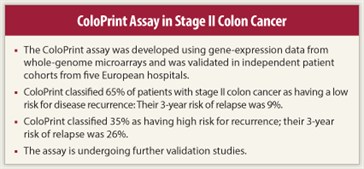ColoPrint, an 18-gene expression profile assay for patients with early-stage colon cancer, accurately stratifies patients by recurrence risk and identifies a subset who can be adequately treated by surgery alone, investigators reported at the 2012 Gastrointestinal Cancers Symposium.1
 According to lead investigator Josep Tabernero, MD, of Vall d’Hebron University Hospital in Barcelona, Spain ColoPrint was more powerful than clinical factors recommended by ASCO for selecting high-risk stage II patients, which include T4 tumors, perforation, fewer than 12 lymph nodes assessed, and high-grade histology.
According to lead investigator Josep Tabernero, MD, of Vall d’Hebron University Hospital in Barcelona, Spain ColoPrint was more powerful than clinical factors recommended by ASCO for selecting high-risk stage II patients, which include T4 tumors, perforation, fewer than 12 lymph nodes assessed, and high-grade histology.
Development and Validation
There is a need for a means of accurately predicting which patients with stage II colon cancer need adjuvant chemotherapy, due to their risk of relapse and metastasis. Since the clinical factors that often guide treatment decisions are not particularly accurate, many patients are unnecessarily treated, he said.
ColoPrint was developed using gene-expression data from whole-genome microarrays and was validated in independent patient cohorts from five European hospitals. Fresh frozen tissues, clinical parameters, microsatellite instability status, and follow-up data for patients were available.
Analyses were performed on 320 patients with stage II colon cancer followed for a median of 70 months. By microarray technology and tumor classification methods, researchers identified a subset of 18 genes that proved to be predictive for the risk of recurrence of stage II and III colon cancer. Using this, they developed a prognostic profile, ie, a classifier of risk, and independently validated it.
In the clinical validation study, ColoPrint classified 209 patients—over 65% of the total—as having a low risk for disease recurrence. Their 3-year relapse-free survival was 91%, Dr. Tabernero reported.
In contrast, 111 patients, about 35%, were classified as being at high risk, and their 3-year relapse-free survival was 74% (P = .001). The 5-year relapse-free survival rates were 88% vs 71%, respectively. By hazard ratio, the high-risk patients had almost a threefold increased risk of relapse, vs the low-risk patients.
Further Analysis
 Microsatellite instability status and the number of assessed lymph nodes were the only significant clinical parameters that stood out in the univariate analysis. Parameters from the ASCO recommendations for the identification of high-risk patients (T4, perforation, less than 12 nodes assessed, and/or high grade) were not significant, and no clinical parameter added power to the ColoPrint classification in the multivariate analysis, he reported.
Microsatellite instability status and the number of assessed lymph nodes were the only significant clinical parameters that stood out in the univariate analysis. Parameters from the ASCO recommendations for the identification of high-risk patients (T4, perforation, less than 12 nodes assessed, and/or high grade) were not significant, and no clinical parameter added power to the ColoPrint classification in the multivariate analysis, he reported.
“Clinical risk factors distinguish the risk groups, but they are not sufficient,” Dr. Tabernero said. “The ColoPrint is better at identifying high-risk patients than any clinical factor alone. It complements clinical and pathologic factors, for making better treatment decisions.”
ColoPrint is developed by Agendia, Inc, which also markets the MammaPrint assay in breast cancer. In the United States, ColoPrint is currently in the final stage of validation, and evaluation is ongoing in the PARSC clinical trial. ■
Disclosure: Dr. Tabernero reported no potential conflicts of interest.
Expert Point of View: ColoPrint Gene Assay Can Guide Treatment Decisions in Stage II Colon Cancer
Reference
1. Tabernero J, Moreno V, Rosenberg R, et al: Clinical and technical validation of a genomic classifier (ColoPrint) for predicting outcome of stage II colon cancer patients. 2012 Gastrointestinal Cancers Symposium. Abstract 384. Presented January 21, 2012.

